On board Van der Valk’s custom 34m Blue Jeans designed over Zoom
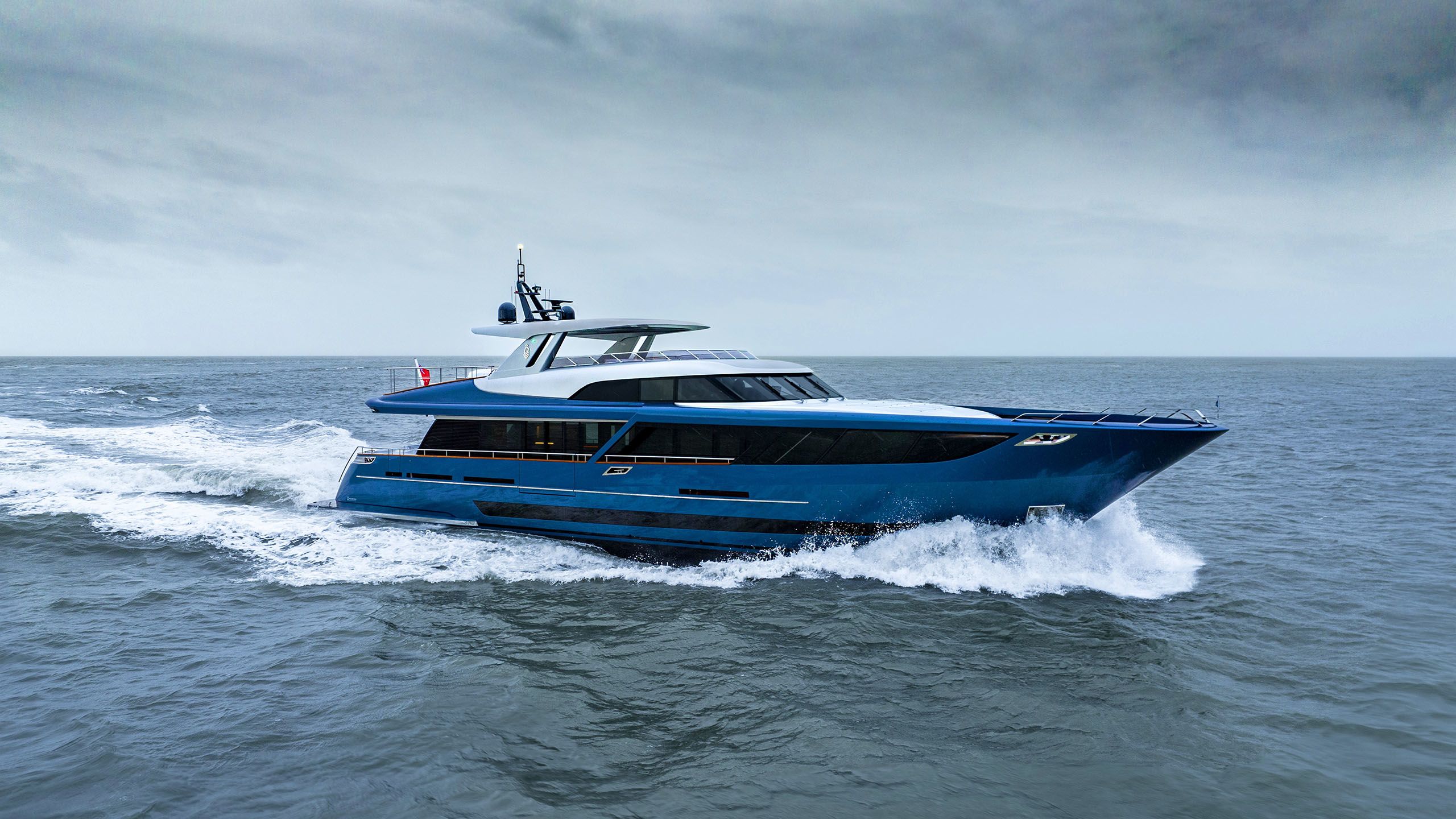
Zoom. Without the essential modern tool of video conferencing, I would not be able to write a line about Van der Valk’s latest launch, the 33.7-metre Blue Jeans. And that’s because the yacht simply wouldn’t exist. From the initial direct contact by email, IT played a central role. The yacht was ordered during lockdown by an Asian client, and Covid restrictions meant that the first time he set foot in the Dutch shipyard in the heart of the Brabant countryside was for the delivery ceremony.
And yet the owner’s fingerprints can be found all over the boat, from the “spoiler” on the transom to the cushions at the bow; from the lapis lazuli basins to the davits on the sundeck. In this sense the boat is a feat of modern technology, and one that Van der Valk was uniquely positioned to realise. “We are one of the very few shipyards that welcomes owners with a wish for a full custom vessel,” explains founder and CEO Wim van der Valk. “In the 20- to 40-metre segment, this makes Van der Valk unique, in a market that is mainly dominated by serial production vessels.”
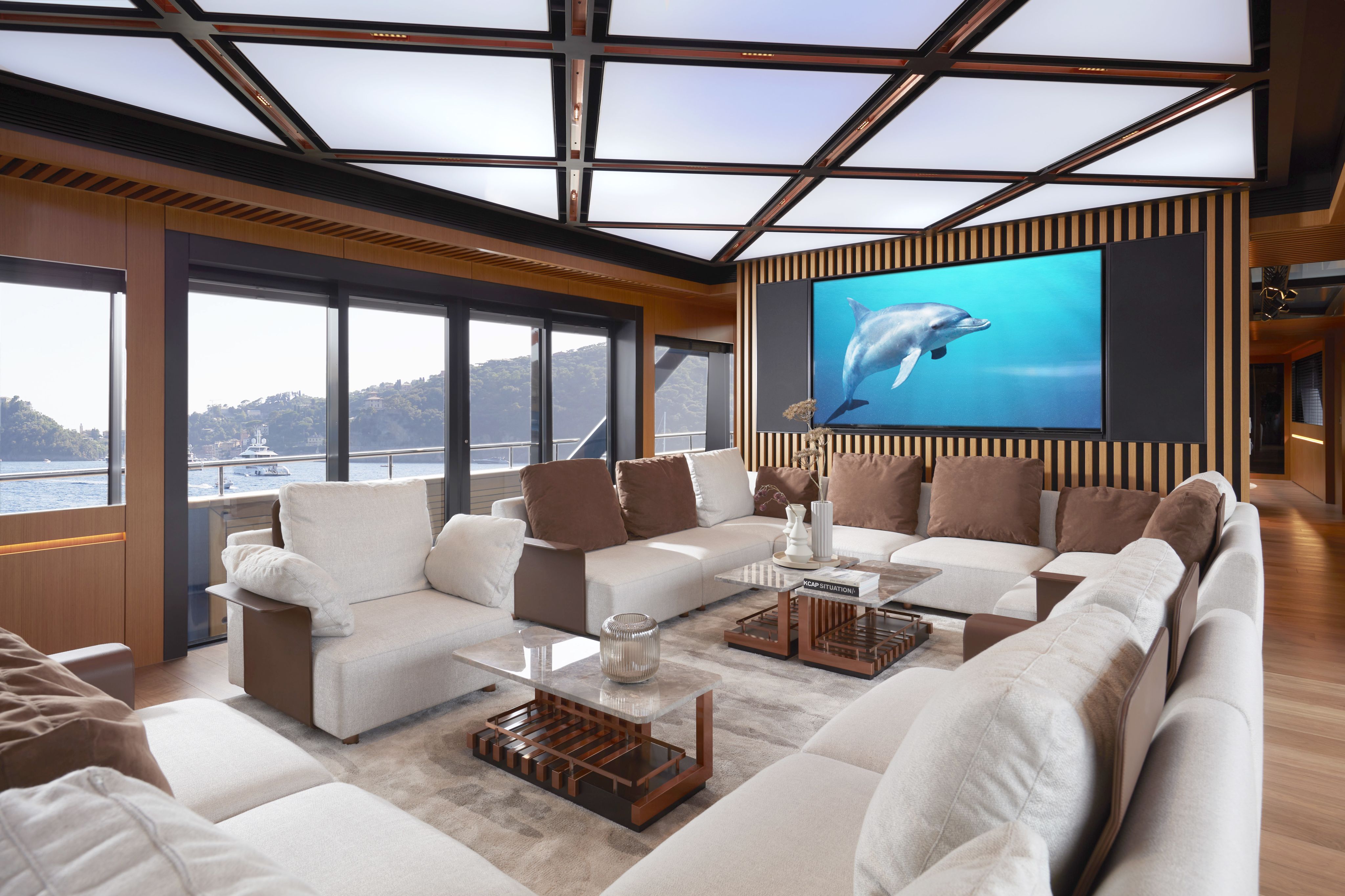
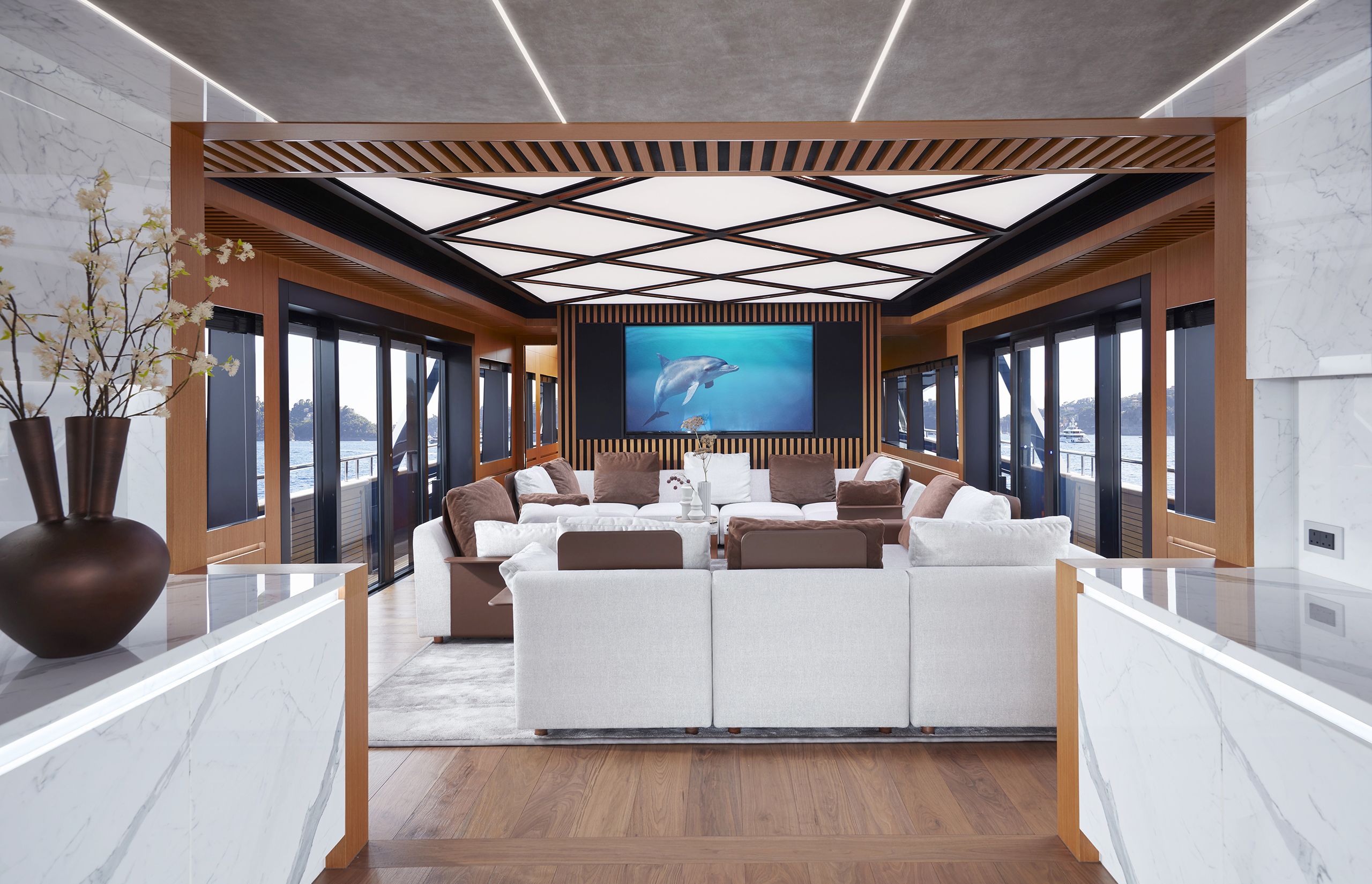
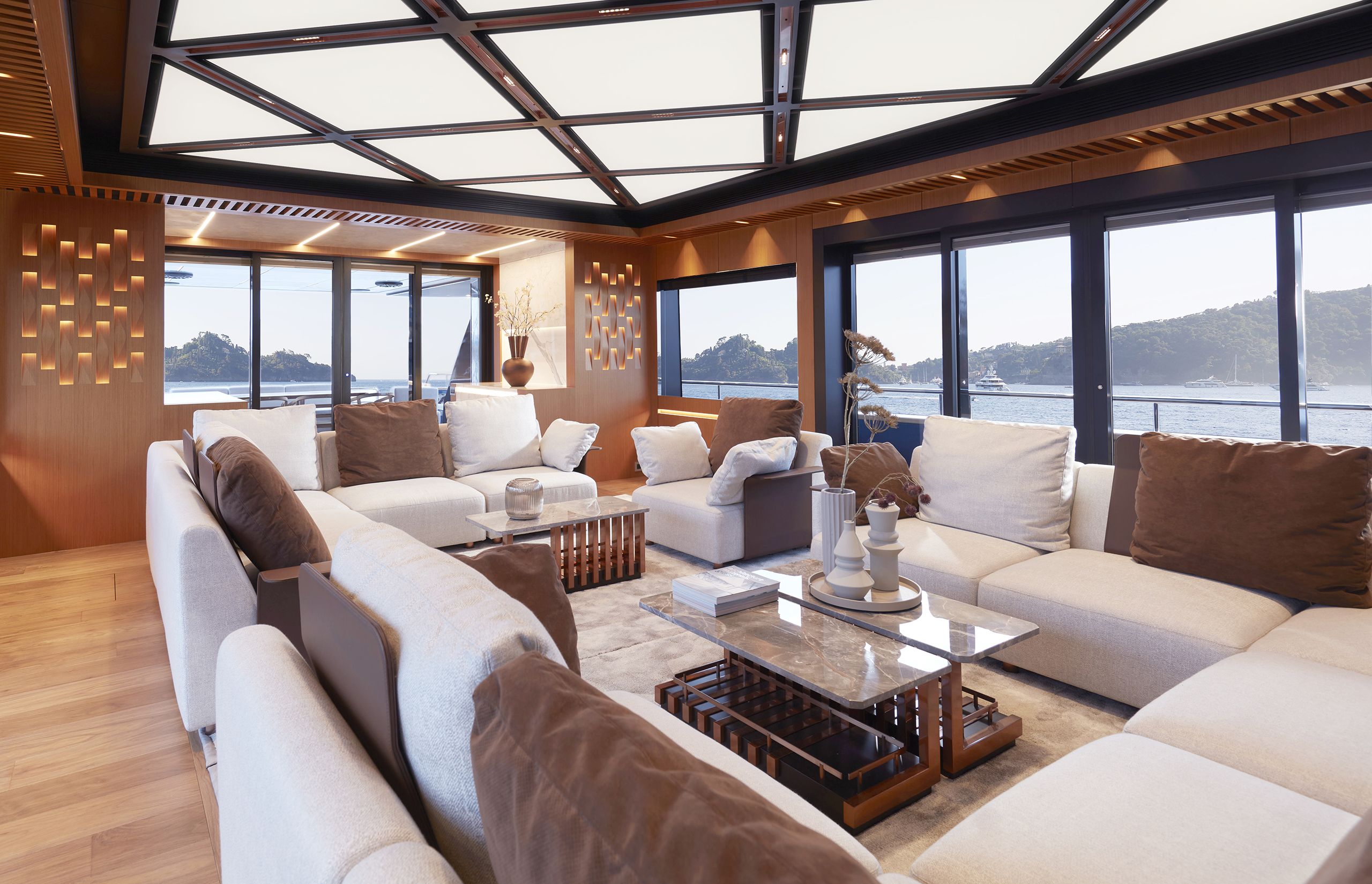
Guido de Groot originally came up with 10 design proposals, all illustrated with a rendering of the main saloon. “The last one had all the crazy stuff in it, and when he saw it, the owner said, ‘you kept the best till last’.”
Notionally based on the established hull of Van der Valk’s raised pilothouse line of roomy twin deck cruisers, Blue Jeans is both longer and faster. This is partly achieved with some nifty naval architecture by Diana Yacht Design. “The hull shape is a hard chine V-shape, which results in a semi-displacement performance optimised for her top speed of 28 knots,” says creative director Hans-Maarten Bais. “Two tunnels over the props make space for the bigger propellers and increase efficiency without increasing the draught. She is equipped with fin stabilisers to reduce rolling and improve comfort on board. All and all, she is a great boat for long cruises or for an exciting run at top speed.”
But the high top speed of 28 knots is also the product of two oversized MTU 16-valve diesels pumping out a muscular 2,600 horsepower each. They are the largest model that MTU builds in its 2000 series and I can attest to the fact that they leave little space in the engine room. Cruising pace is an eye-watering 25 knots, according to Van der Valk’s commercial director Yoeri Bijker. “The owner wanted the extra power for safety,” he says.
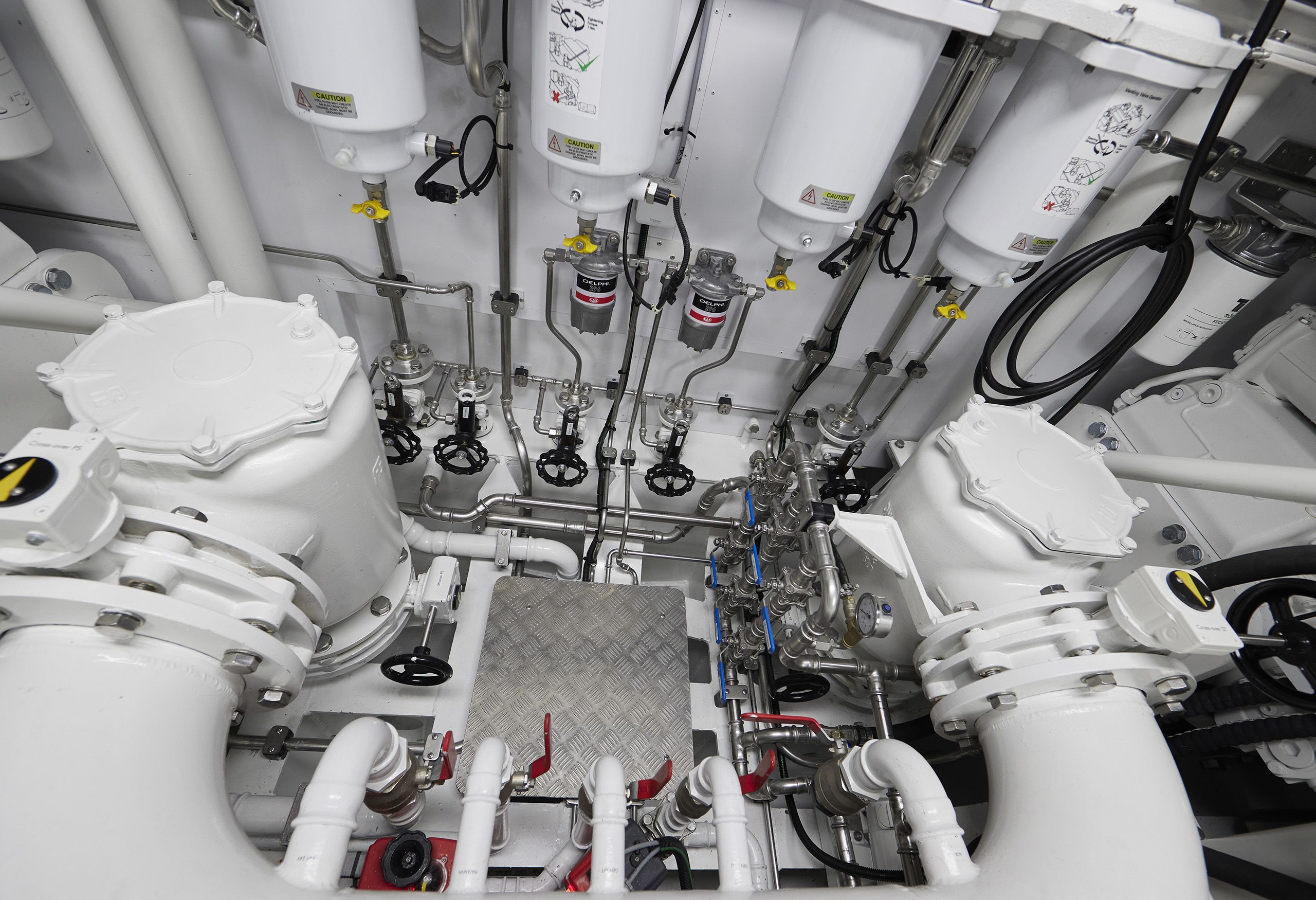
VAN DER VALK
VAN DER VALK
A top speed of 28 knots is the product of two MTU 16-valve diesels pumping out a muscular 2,600 horsepower each.
Don’t expect ocean-crossing range at such rapid pace. In fact, Blue Jeans has been purposefully engineered and equipped to fall short of full transoceanic range. Or rather, the emphasis has been on other features that make more sense to an owner who previously has favoured Viking sportfishing yachts. Although the yard was busy installing an additional 1,200 litres of diesel tankage when I visited the boat on a foggy November morning, she is not heading to Asia on her own bottom. The hull is perfectly capable of tackling an ocean in great comfort, but the owner plans to use her more for entertaining and coastal cruising.
This has given rise to some intriguing features. There is a retractable diving board hidden in the sundeck, for instance, which slides smoothly out of the custom blue superstructure. Apparently, it is a standard part produced by Opacmare – who knew? Then the owner insisted on a fairly radical lounging space on the foredeck, which required the deck here to be raised by about 30 centimetres. This allows the ground tackle to be placed under the deck in a shallow locker so that the entire bow can be covered with cushions to create a gigantic lounge area, complete with a drop-down table. “Originally, the forward decks would have been lower,” says Bijker. “But the owner said, ‘in Asia we are always lying on cushions on the floor’, so we covered the whole bow like this.”
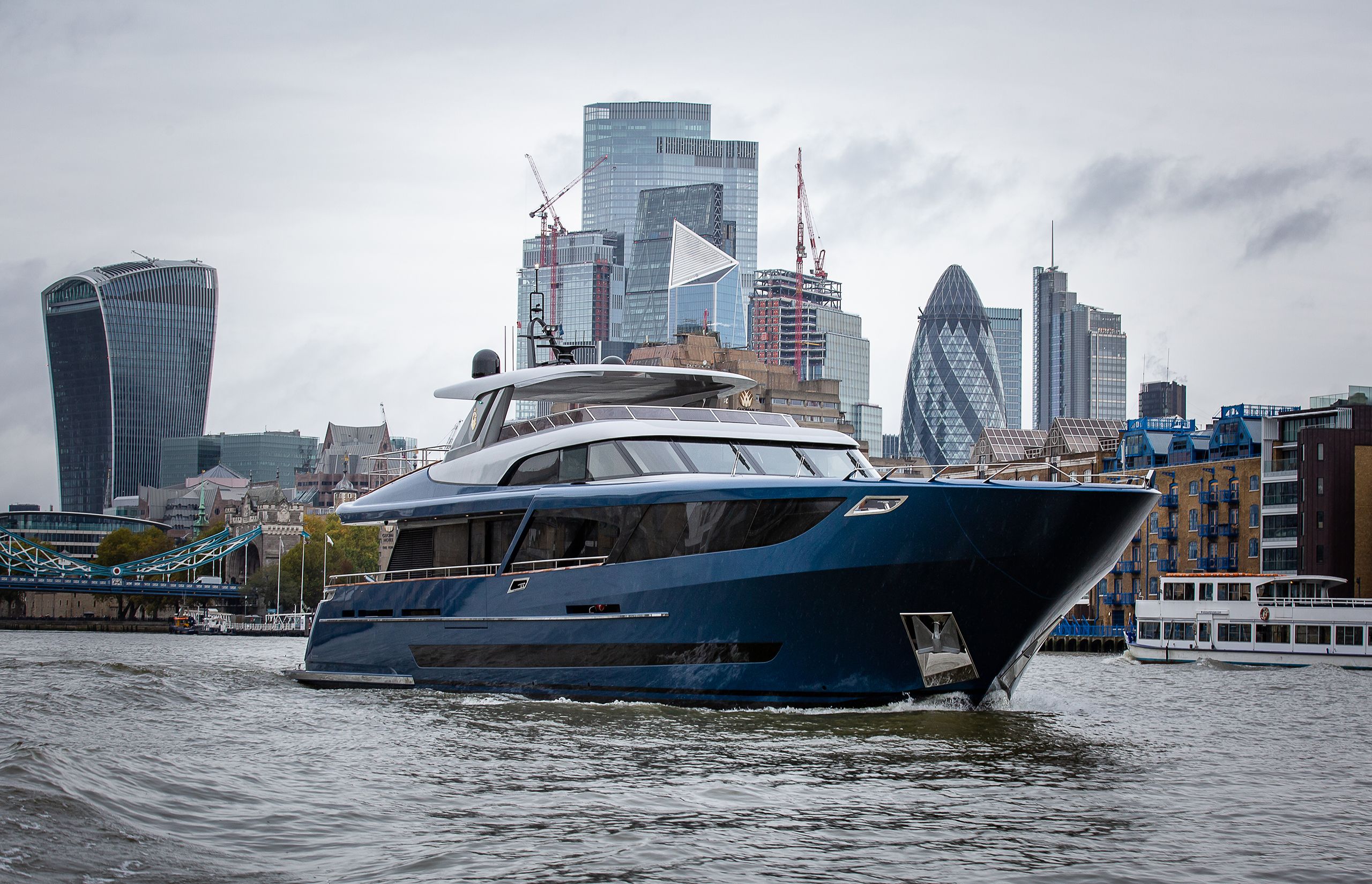
That aforementioned spoiler is another example. In fact, it is a teak-lined ledge that runs along close to the top of the transom door. “His idea was he could sit on the sofa above and dangle his feet down, admiring the view astern,” explains Bijker.
Where some similar sized yachts would have covered the aft decks with sofas and chairs, loungers and other furniture, Blue Jeans is relatively restrained. You can find these amenities on both aft decks, but on the upper sundeck, there is plenty of empty space. Bijker directs my attention to a pair of stainless-steel capped deck sockets. “These are pop-up deck sockets for davits,” he tells me. “So the crew can raise and stow the owner’s WaveRunners.”
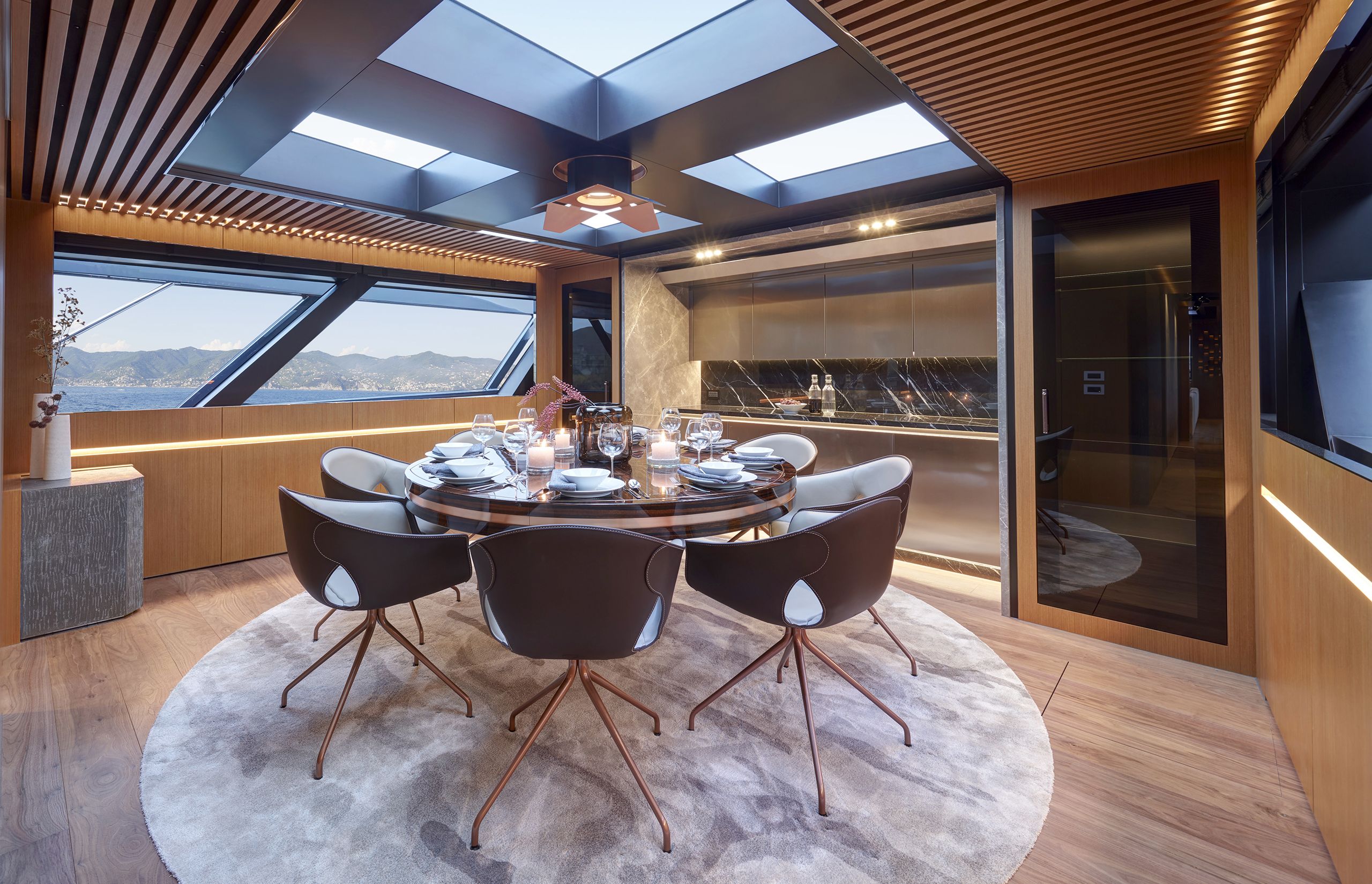
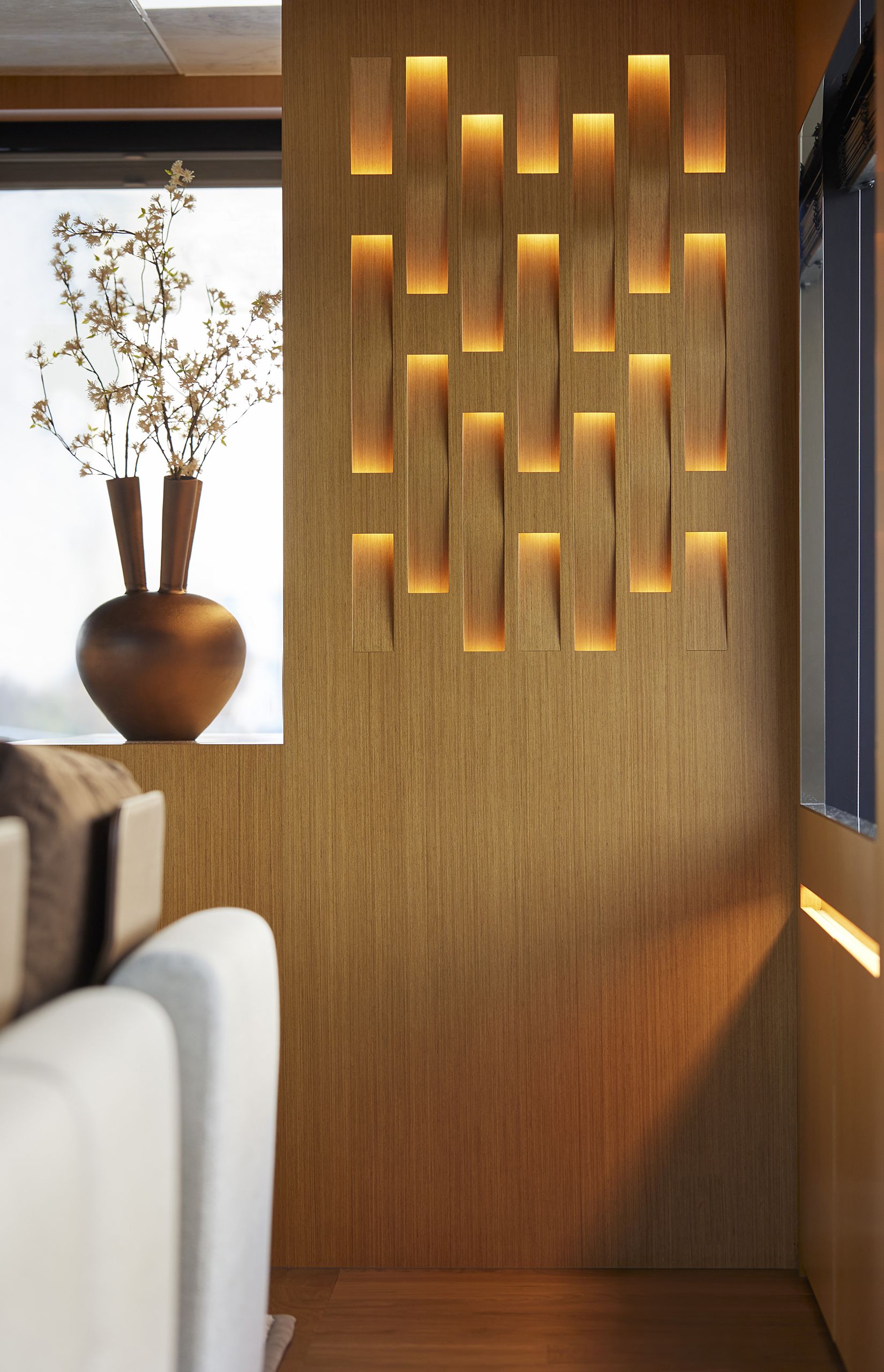
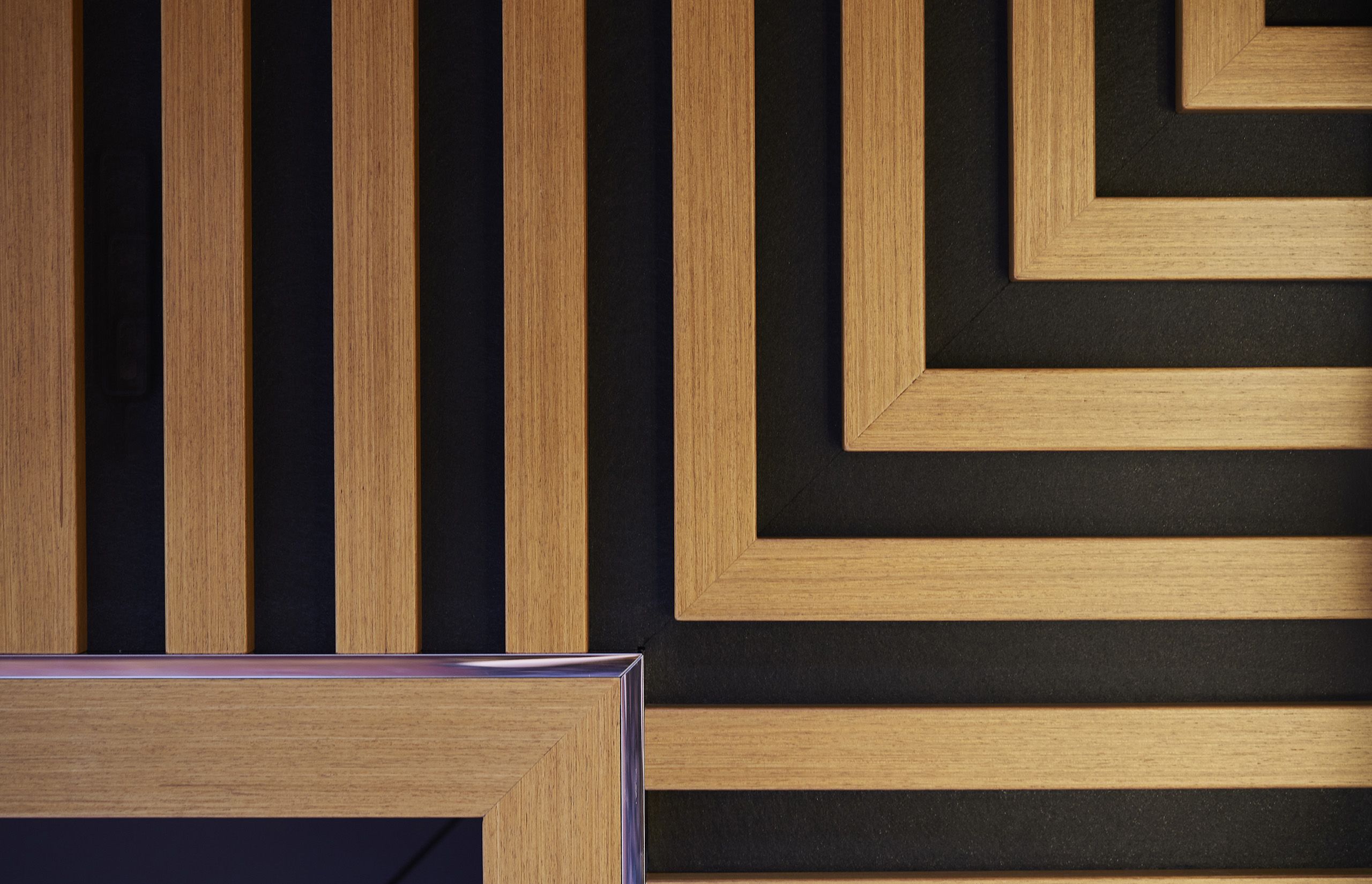
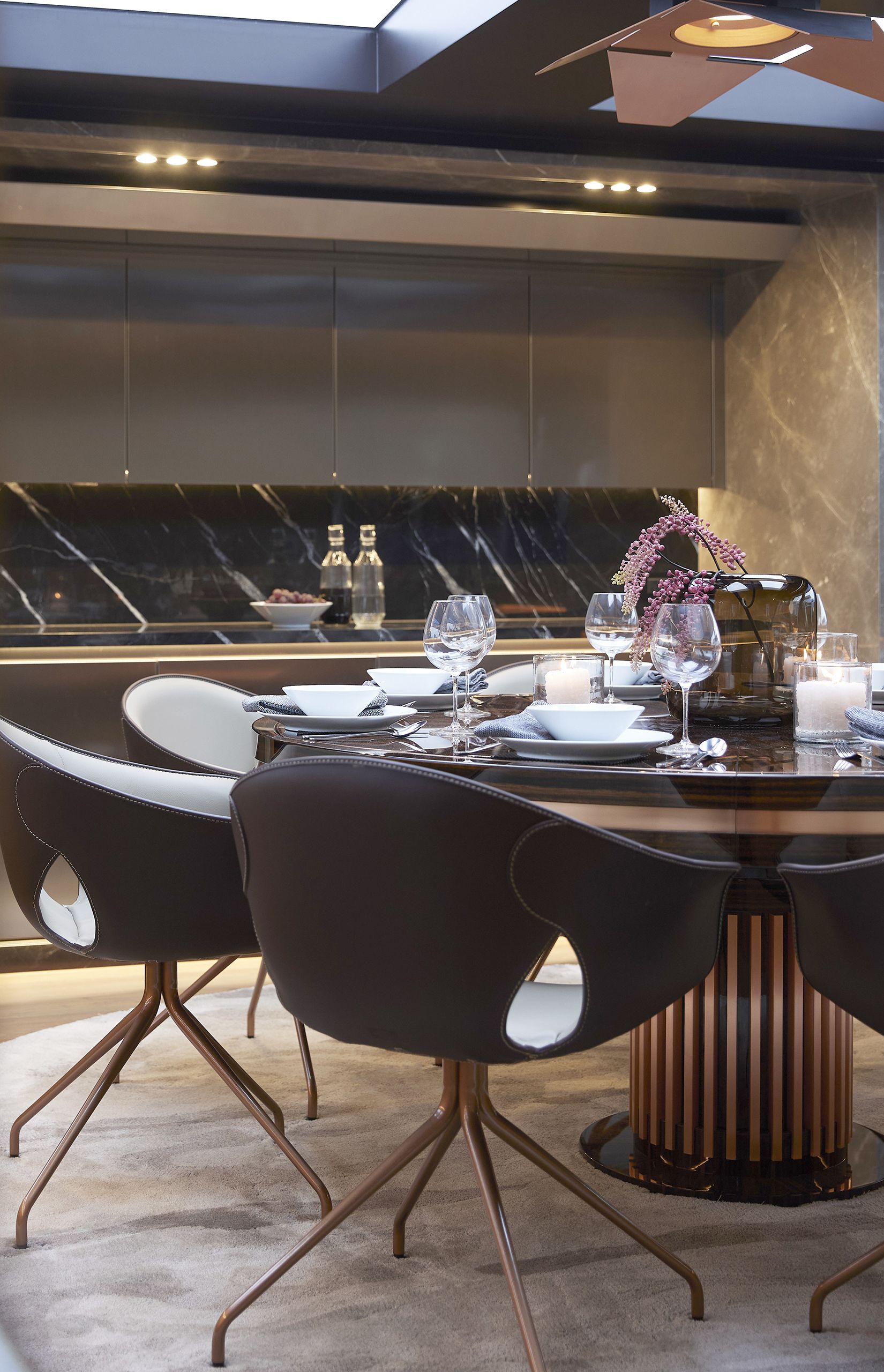
The Fletcher Capstan table (top left) is mounted on an intricate gearing system and will grow from a 1.7-metre radius to a 2.2-metre radius when rotated
More original thinking can be found through one of the five doors that lead inside to the main deck. Although some yachts in this size range put the owner’s suite forward on the main deck, this owner has chosen to put a rather spectacular dining room here instead. There is good logic to this, as it’s right next to the galley.
Its real delight, beyond the long views out through the glass bulwarks, is the table. It’s a Fletcher Capstan, and I have never seen anything like it before. Mounted on an intricate gearing system, the circular wooden-topped table will grow from a 1.7-metre radius to a 2.2-metre radius when it is rotated. The motion is mesmerising, as the marquetry splits into polygonal shards, which then radiate out from the centre. Further shards concealed under the table top also slide out, then up to perfectly fill the gaps vacated by the expansion. The final twist sees all the elements click together. Representing an investment of some €250,000, this is functional art of the highest calibre.
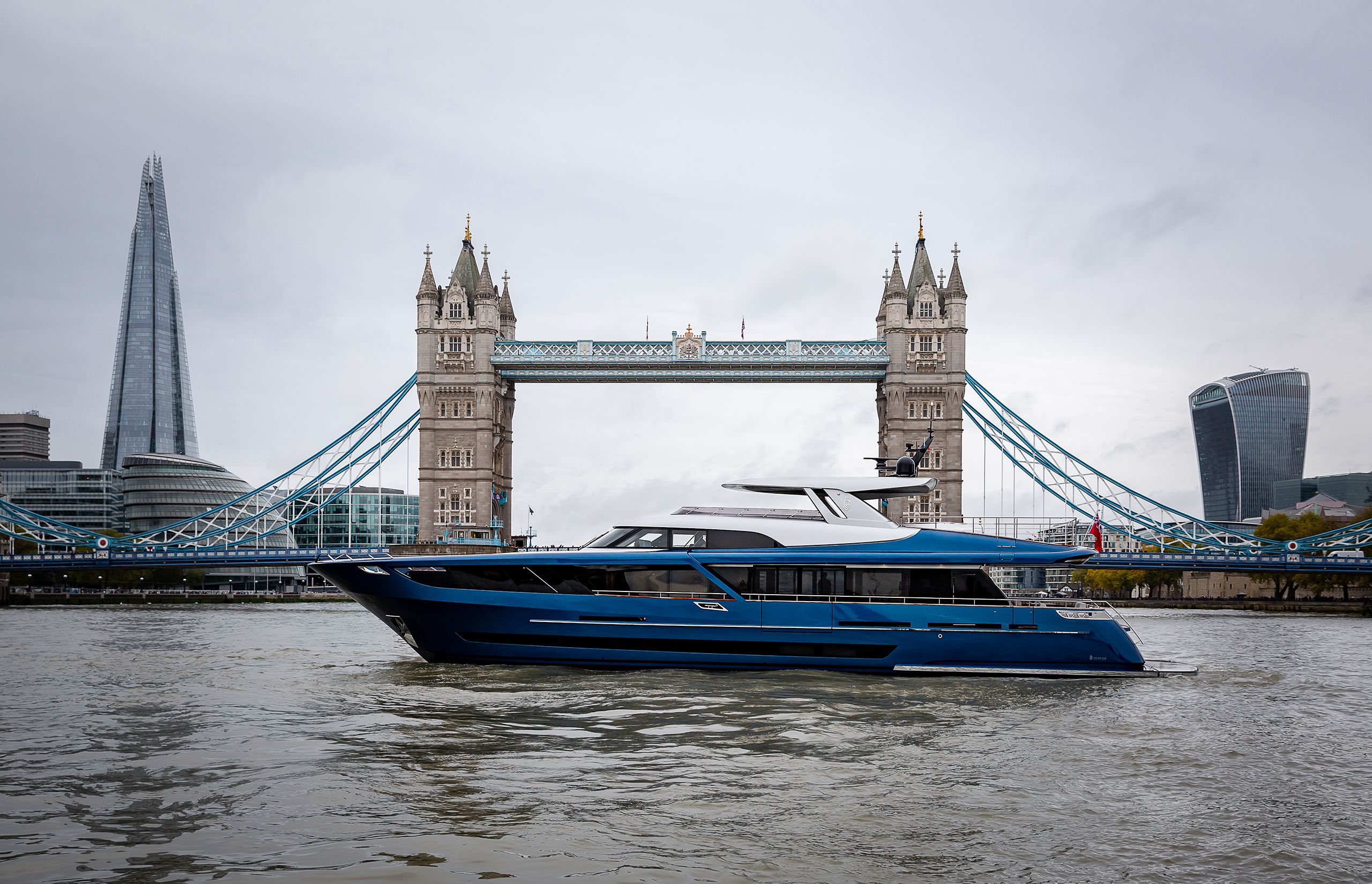
This space will also serve a double function as a gaming room when the dishes have been cleared. No doubt the owner is counting on winning back some of his outlay on the Fletcher. Four large skylights, jokingly referred to as missile silos by the owner, would make this an atmospheric space by day or by starlit night. And a lamp inspired by theatre spotlights shines down on the centre of the table, where its glow is reflected around the room by the deep lustre of the striated macassar ebony.
“The brief from the owner was that this should look like a north European interior, but the samples he gave me looked very Asian,” says Guido de Groot, who designed the boat’s interior and exterior. “We had long design meetings with him, spending hours on Zoom. We knew a little about what he liked in terms of home interiors, then he said, ‘surprise me’. It was music to our ears!”
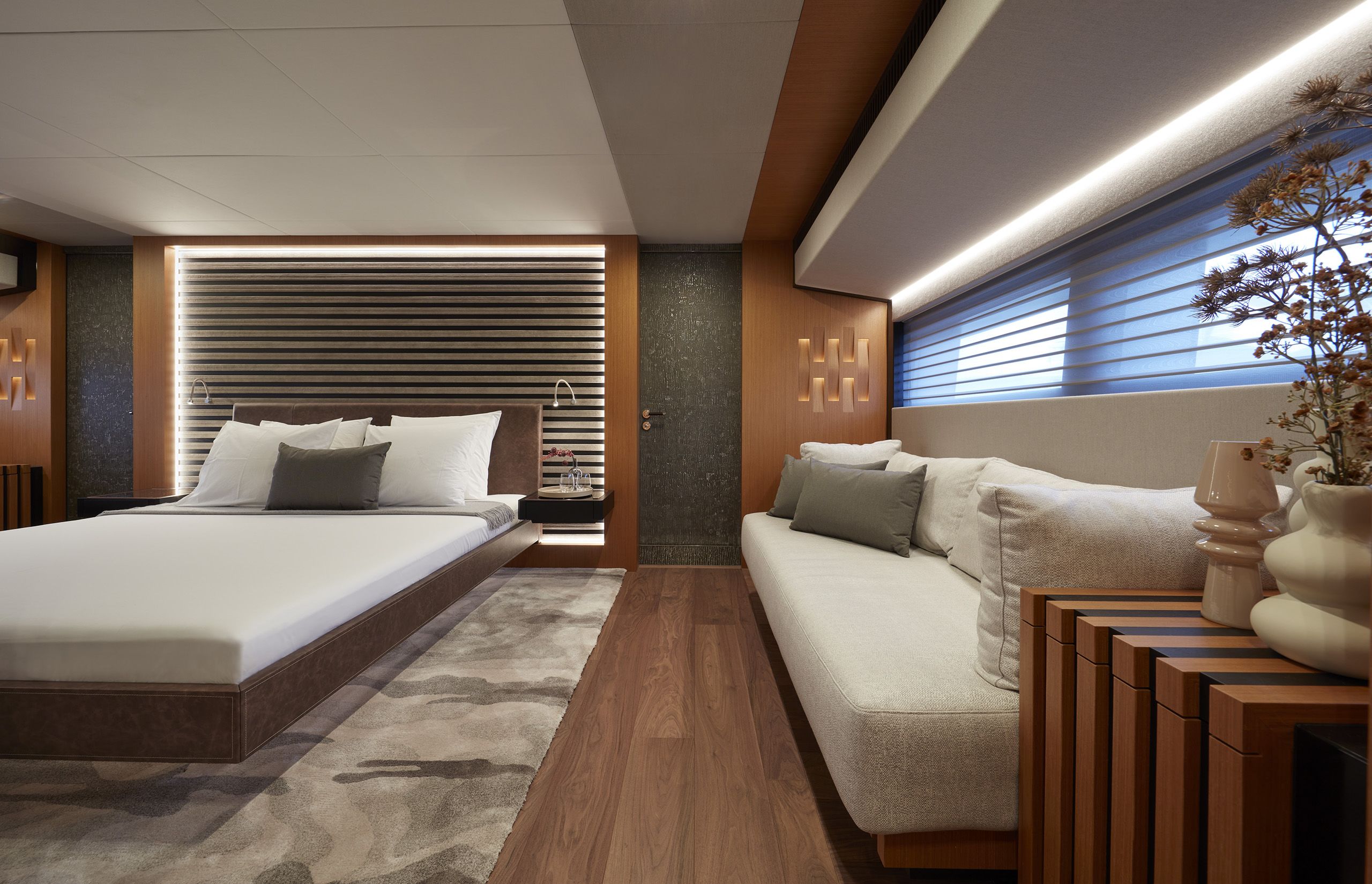
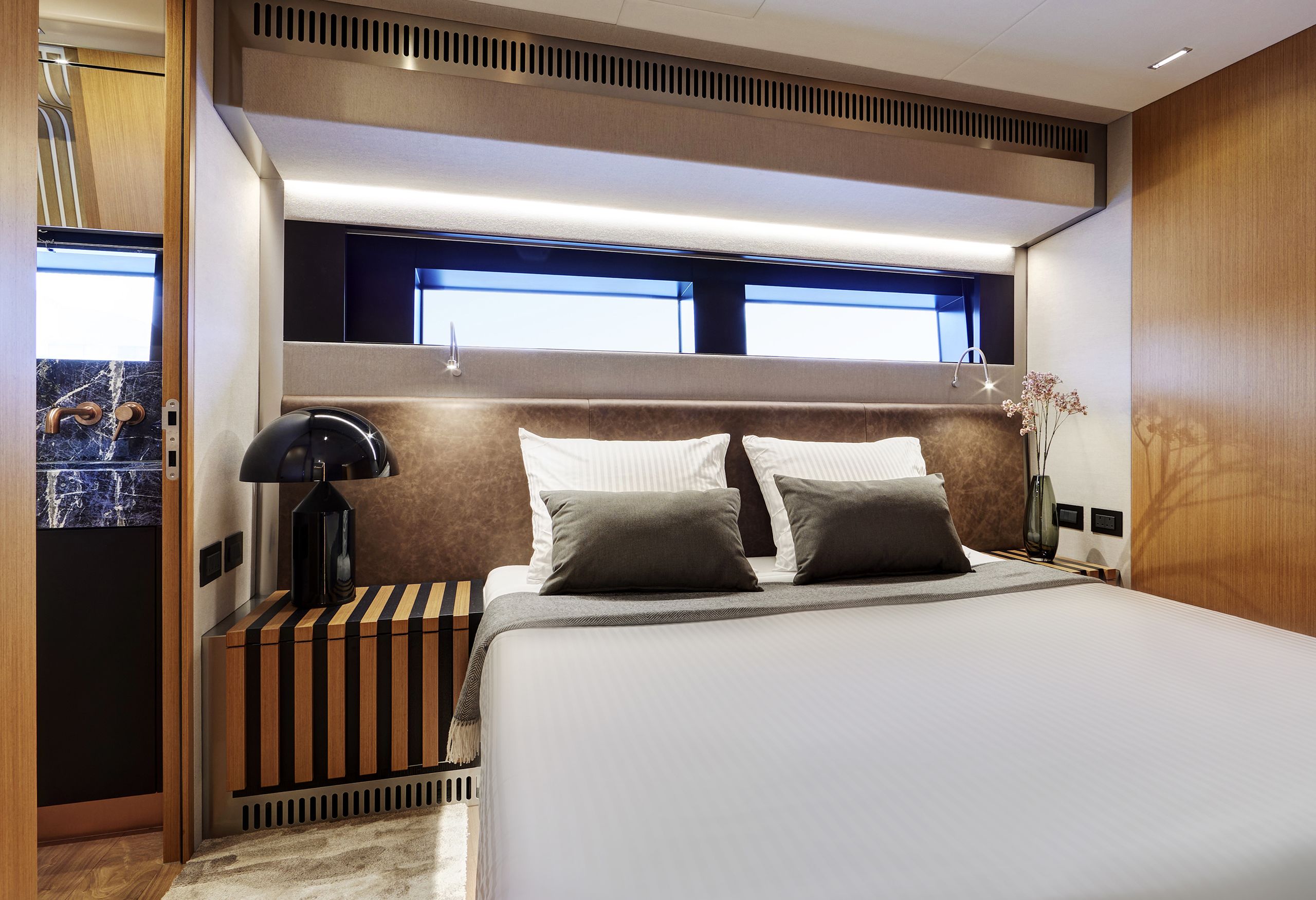
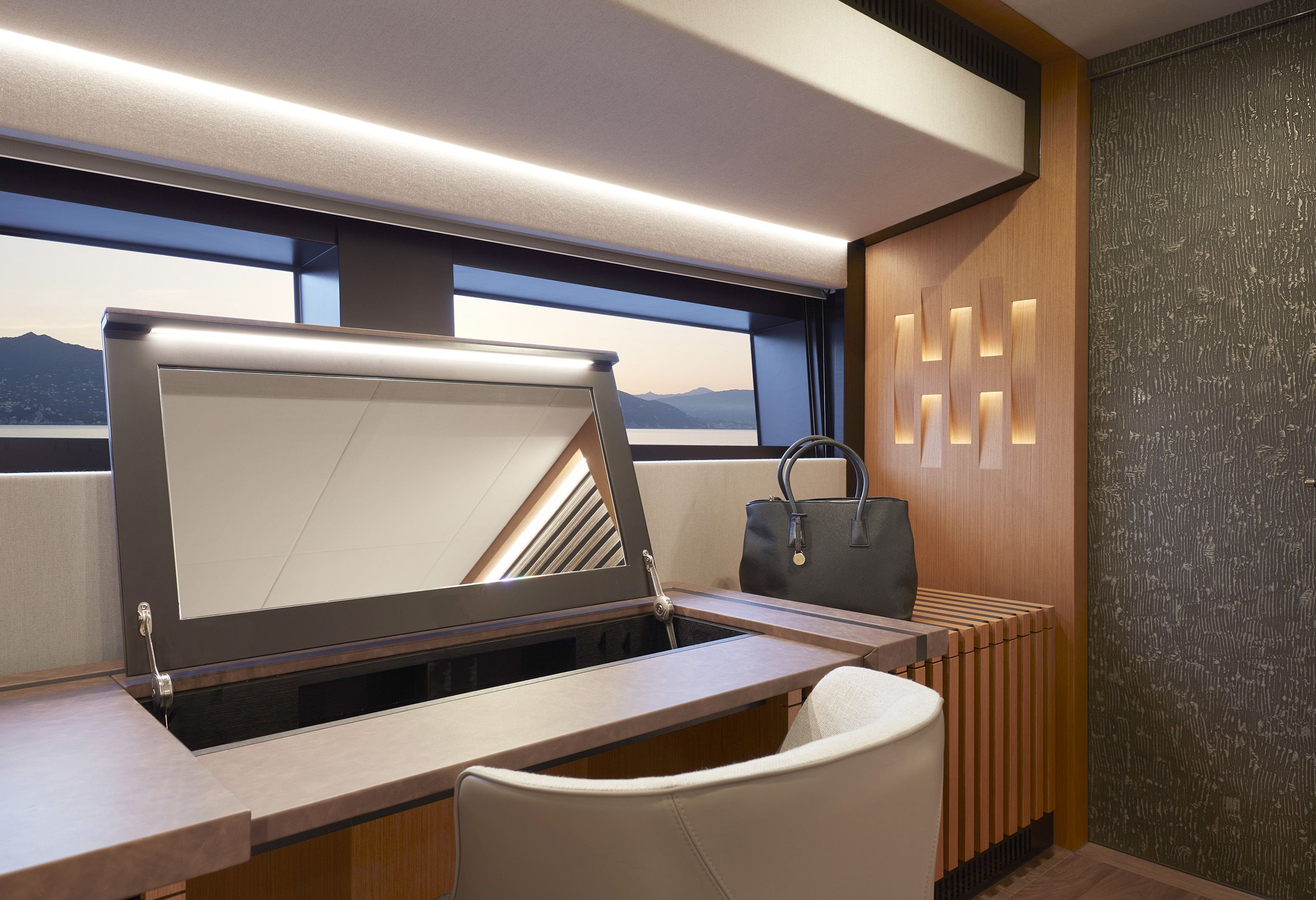
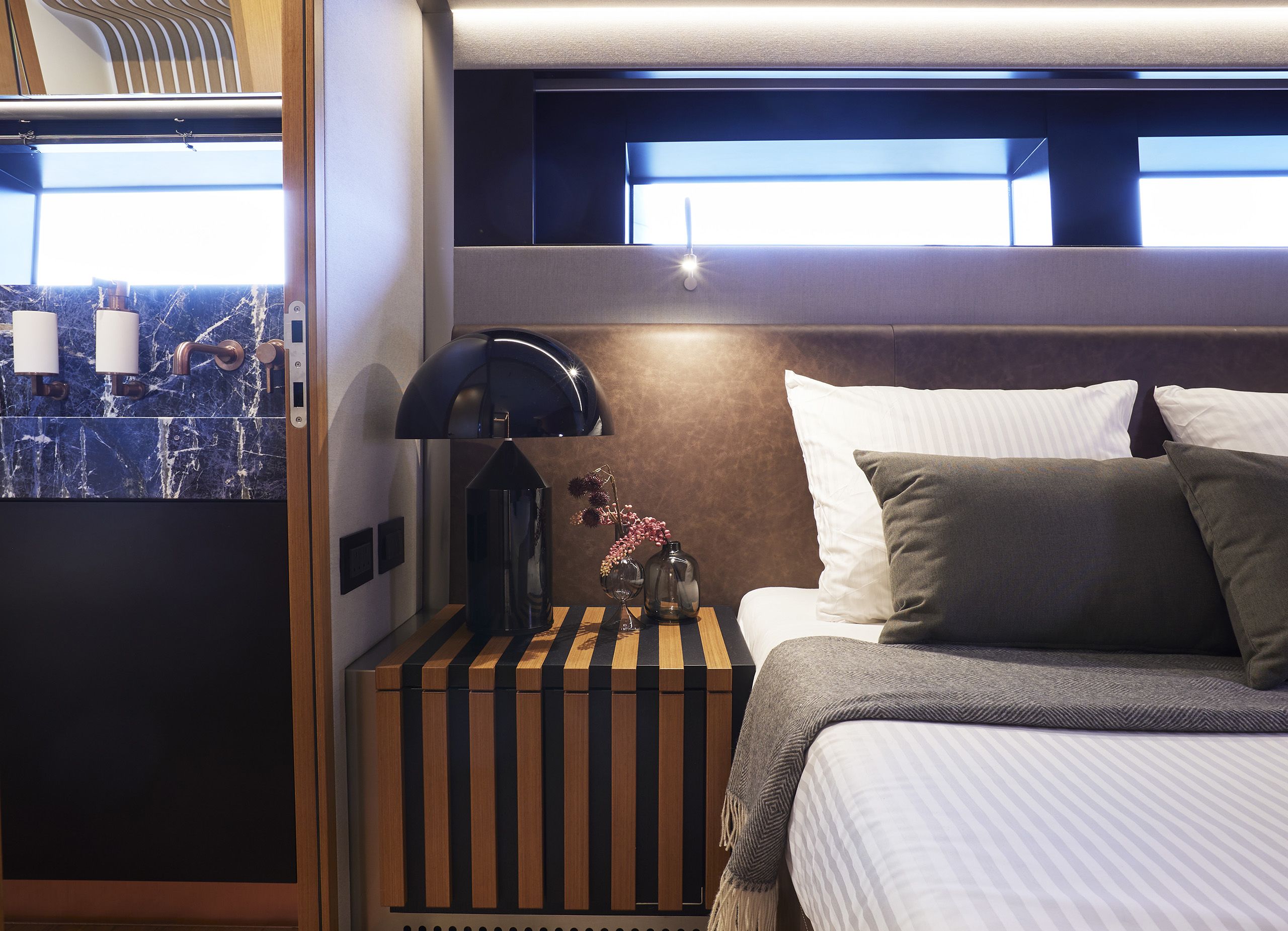
Bedside lamps evoke the Asian style of original samples provided by the owner. Bottom right and centre: slatted teak veneer lends texture to the walls
potential to become a bit of a contradictory mishmash, but de Groot and his team have approached the brief sensitively. Thus, the boat makes strong use of slatted teak veneer to lend texture to the walls, as well as slick grey marble for panelling and tabletops. The palette is a restrained blend of natural tones allied to contrasting white and black.
“The owner likes materials to look as they should: raw,” explains de Groot. “That is to say that metal looks like metal, and wood like wood. To begin with he even wanted a bare aluminium hull for the boat.” This was quickly set aside when the yard demonstrated how fast unprotected aluminium dulls with oxidation. But the interior is a different matter, containing lots of noble materials in a raw state.
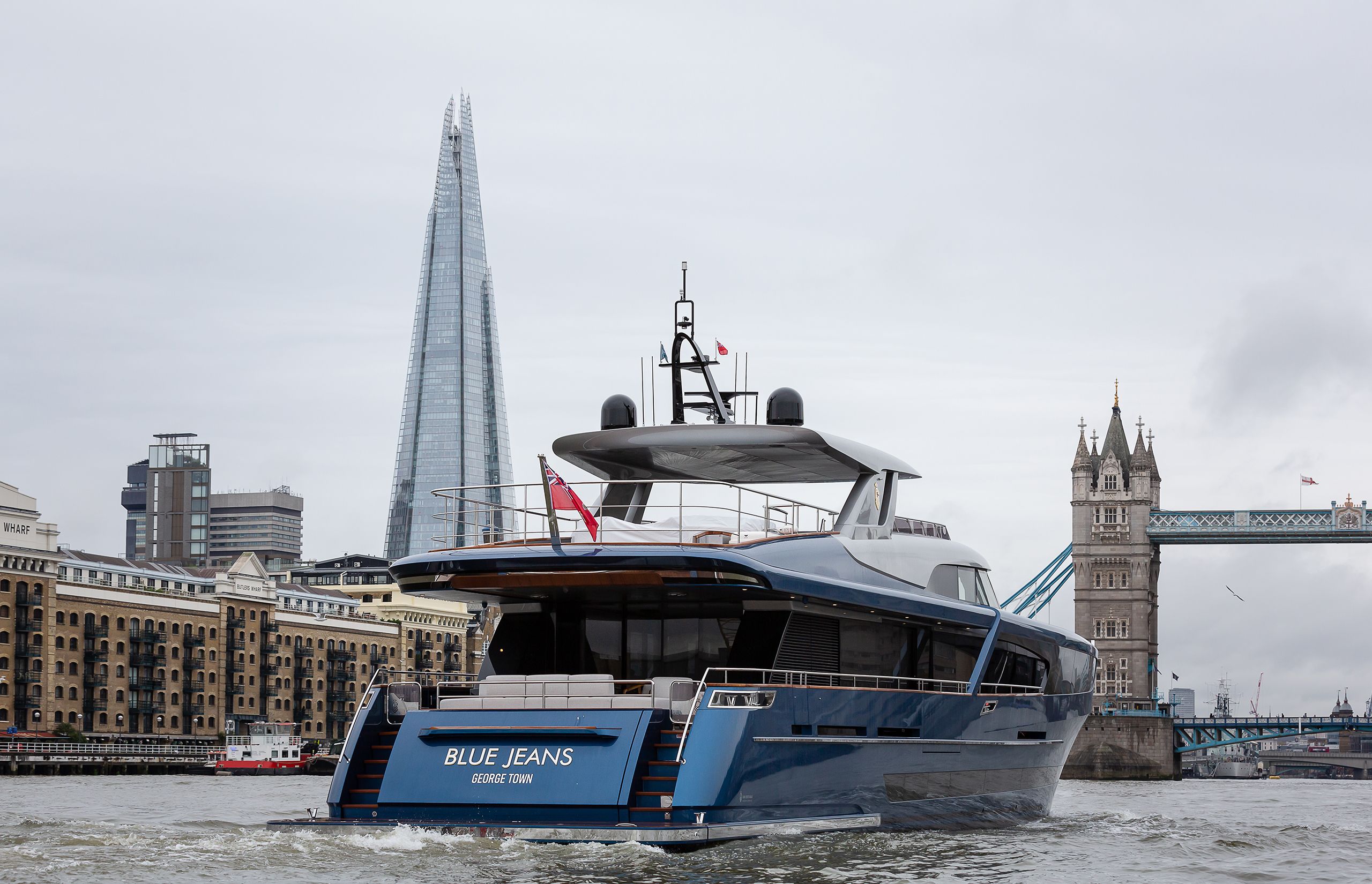
Rich copper detailing, for example. From edging around the dining table’s outer leaves to the bathroom fittings, all the copper has precisely the same rosy glow. And though it looks to be in a state of nature, it really isn’t – there is art employed in keeping it looking like this, according to de Groot. “The copper elements are all nano coated to keep them from deteriorating in the marine environment,” he says. What’s more, suppliers all had to match the exact copper alloy in their finishes.
So-called liquid-metal finish has been used to decorate wall panels, which look and feel like textured metal that has been combed into an irregular pattern. “We must have tried 20 different samples, because it’s very difficult to get the right tone,” says de Groot. “In the end, we went for a tungsten alloy.”
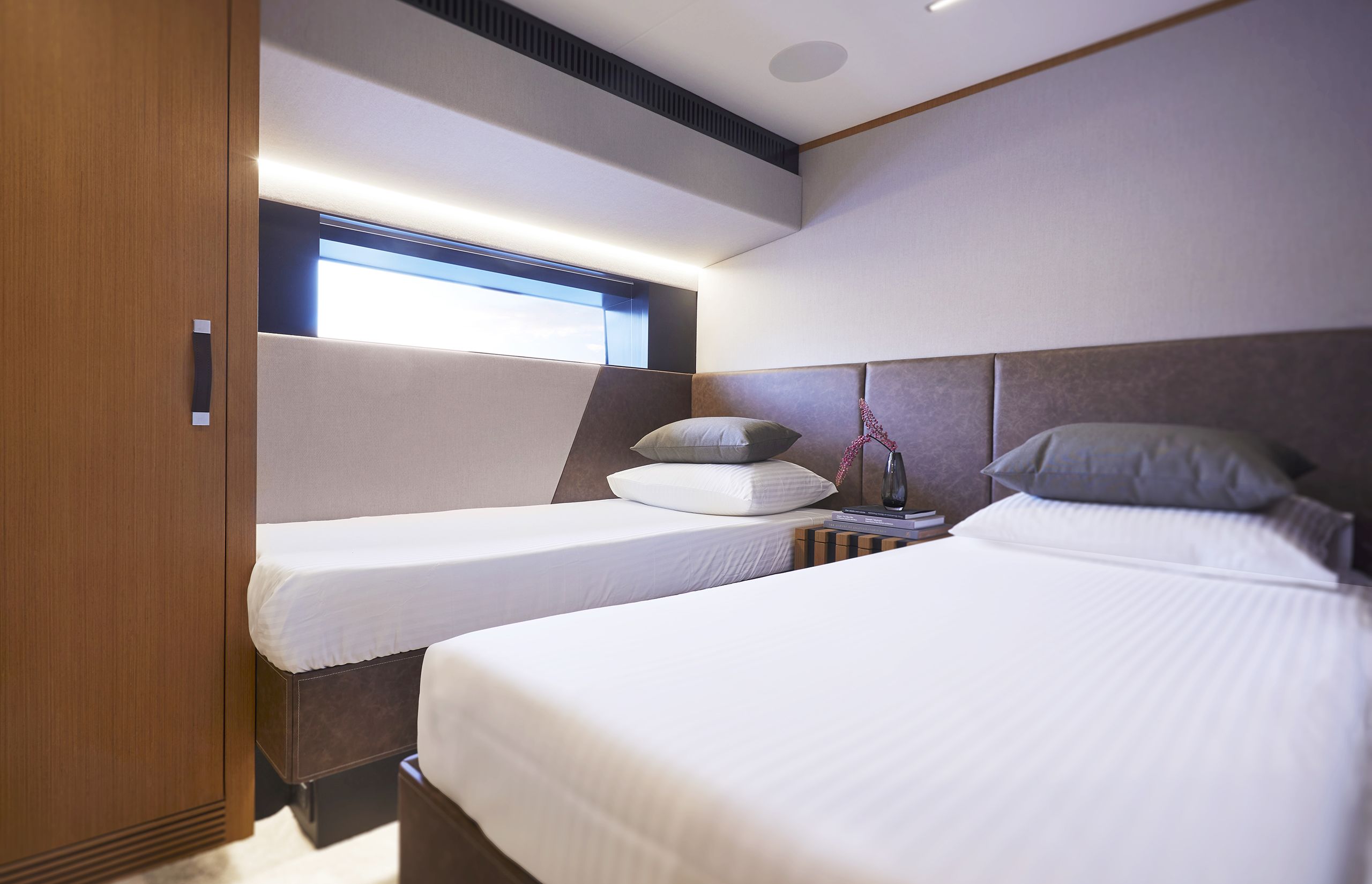
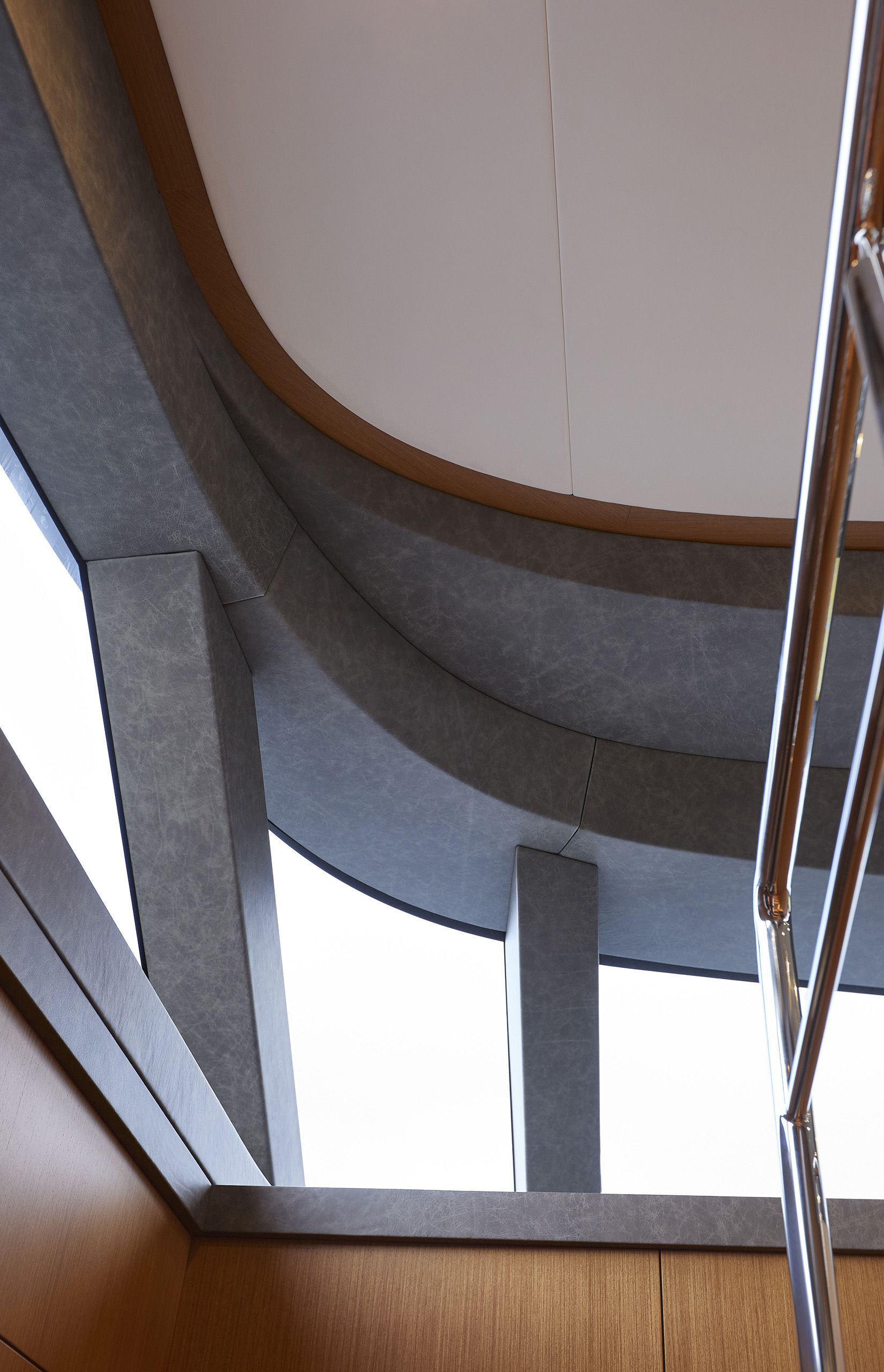
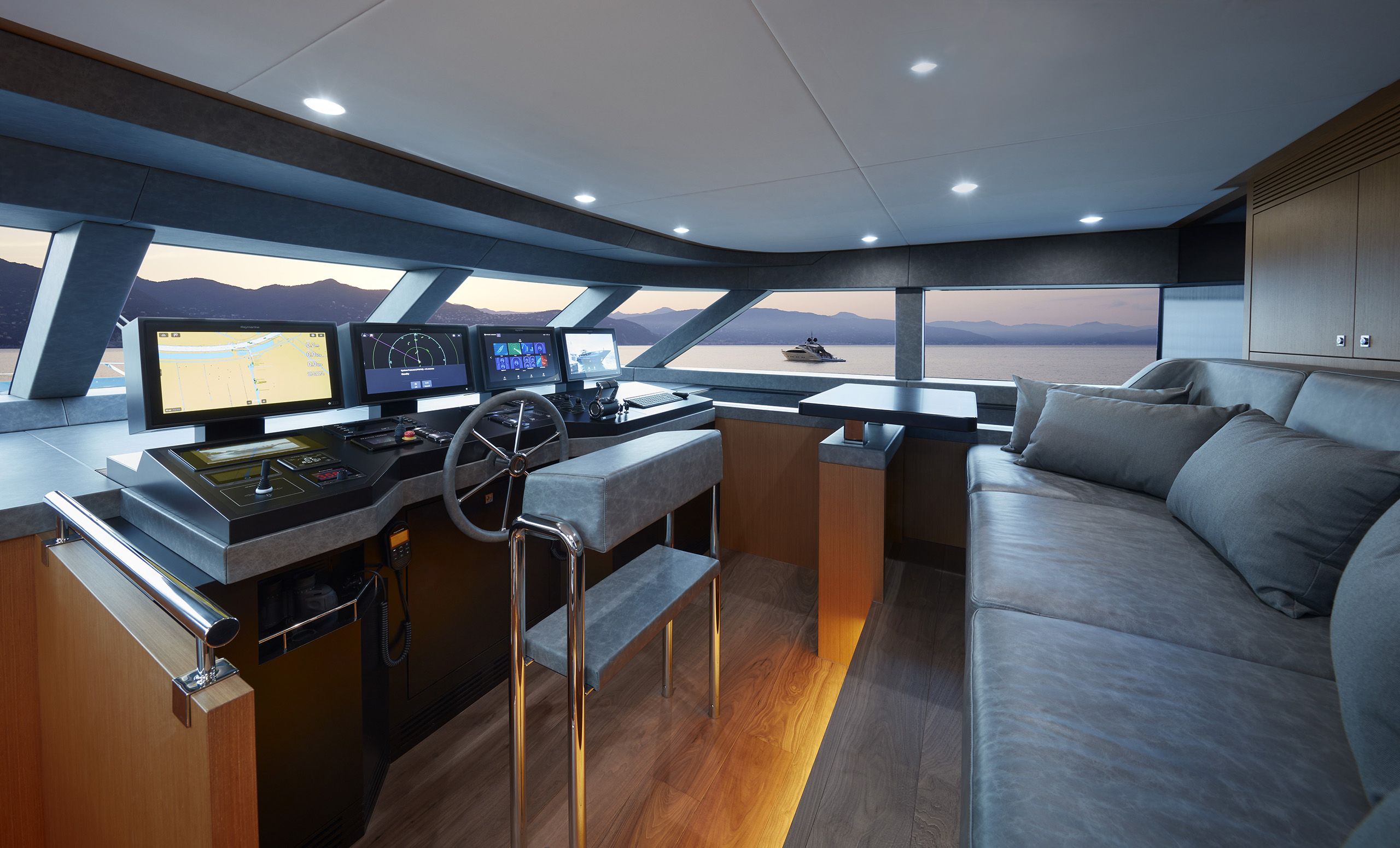
Raw materials play a key role in the design, with teak, stainless steel and a liquid-metal finish on wall panels featuring in different rooms
Stainless steel also features widely, lending a slightly industrial vibe to some areas. De Groot has toyed with this styling in the main deck corridor, where he has hung mini stage spotlights from a black gantry construction overhead. It wouldn’t have worked on many boats, but here on the main deck he is assisted by the generous 2.5-metre height of the deckheads, a feature that also adds tremendous volume to the main saloon and allows the wheelhouse to be positioned on a half deck above the galley.
De Groot has also developed another unique feature in the main saloon, in the form of backlit ceiling panels made of opaque Barrisol fabric stretched over a thin frame. A copper-coated lattice carries further LED lighting, and the whole assembly has been programmed to create different moods. With the contemporary Poltrona Frau sofas positioned around the deep woollen carpet, a warm light creates the best effect. But move the modular furniture out of the way and roll up the carpet, and the stage is set for an explosion of multicoloured lighting that simulates the roving spots of a nightclub.
Another nice touch is the dayhead next to the saloon, which also runs to a fine marble-clad shower, allowing visitors to refresh themselves after stepping in from the heat. The marble in question is rare lapis lazuli from Afghanistan – an expensive luxury on which the design team had to make a very quick decision. “We got it just in time,” says de Groot. “We needed to act very fast in buying it – the importer sent us a message with a photo and we had to decide the same day. If you don’t take it, it’s gone to someone else.” The stone also forms the basins and backsplash in the owner’s bathroom, painstakingly matched across numerous joints. “A vein can ruin the whole effect, so you have to make a design on the stripes.”
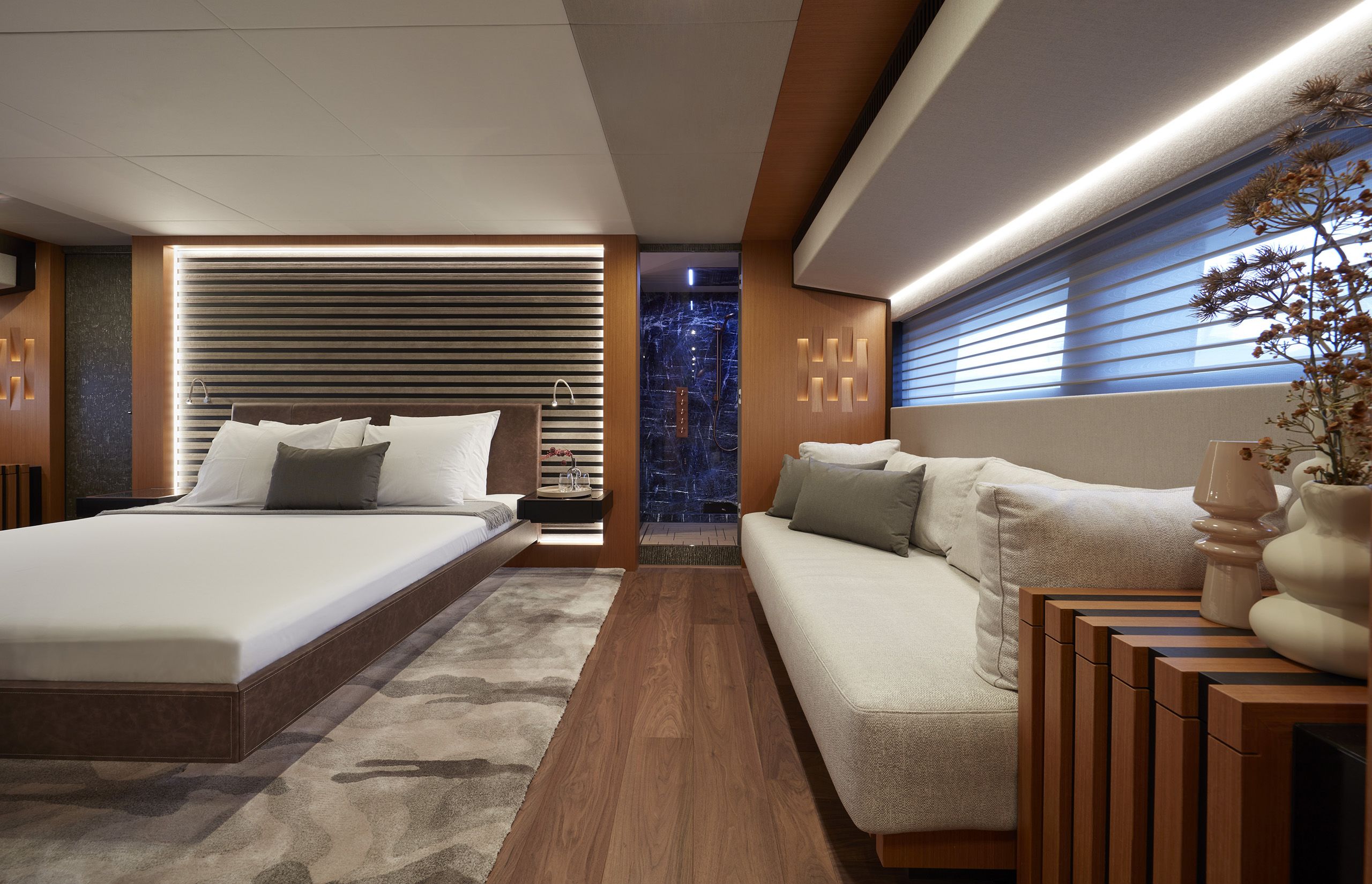
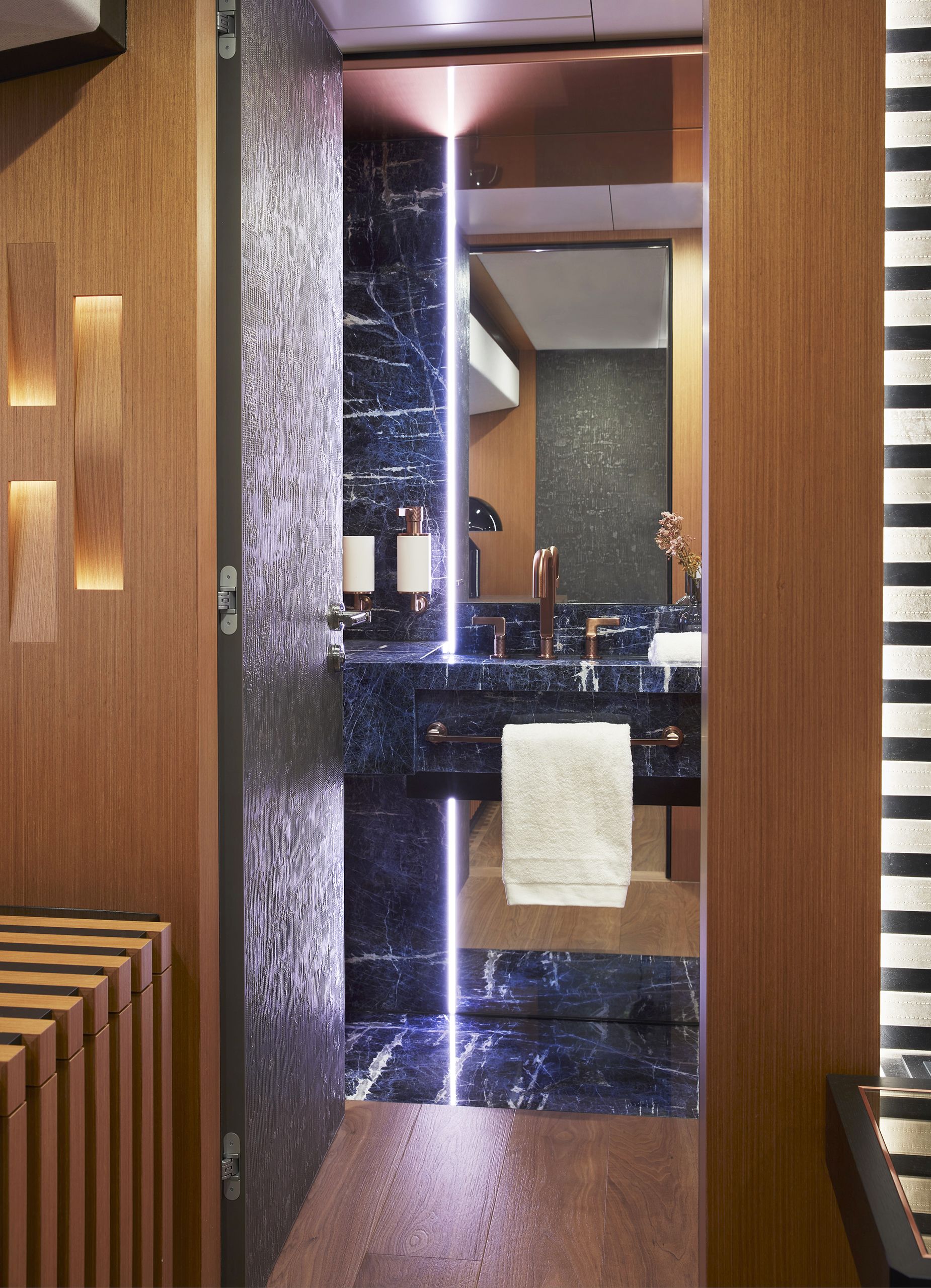
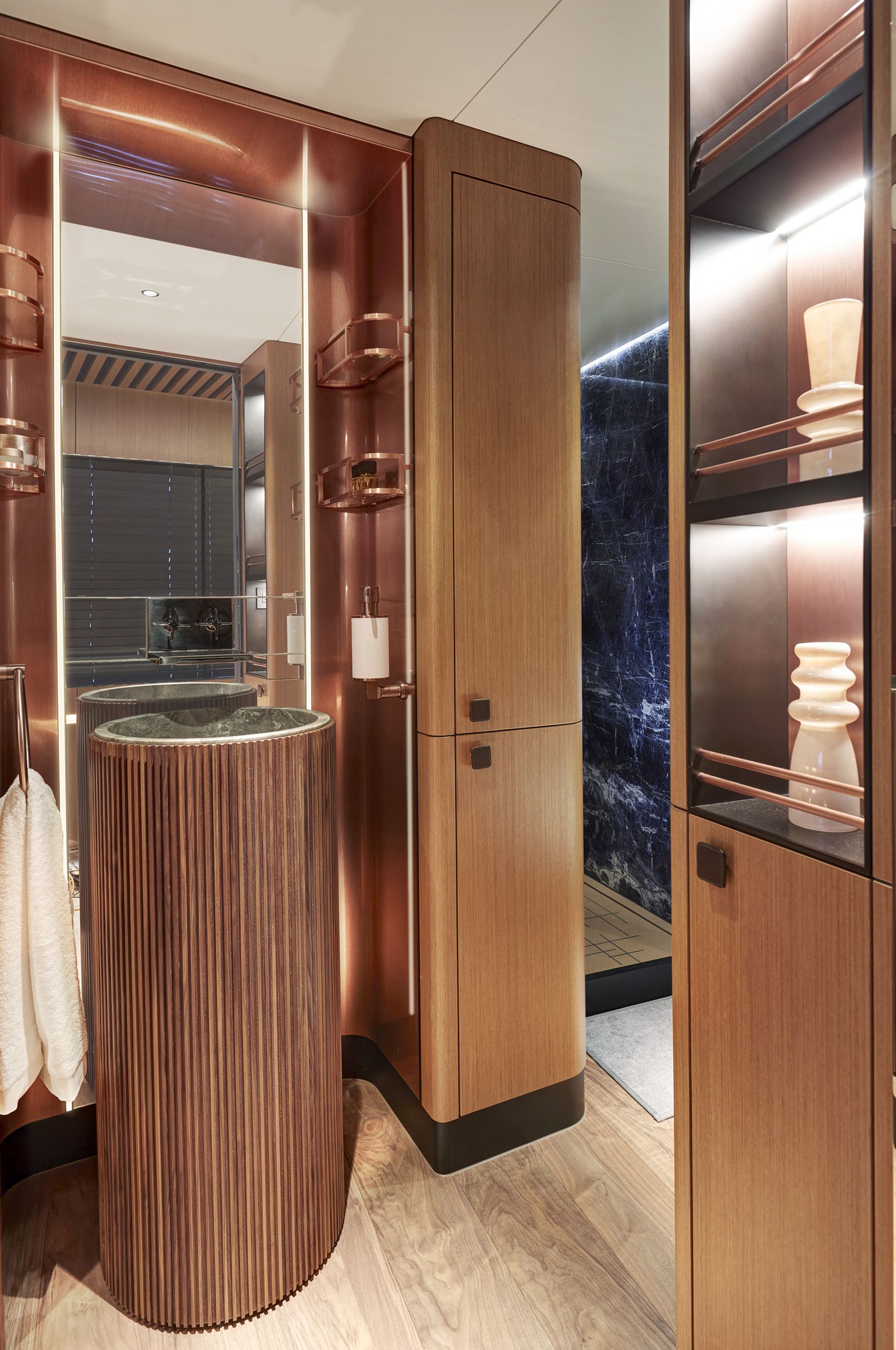
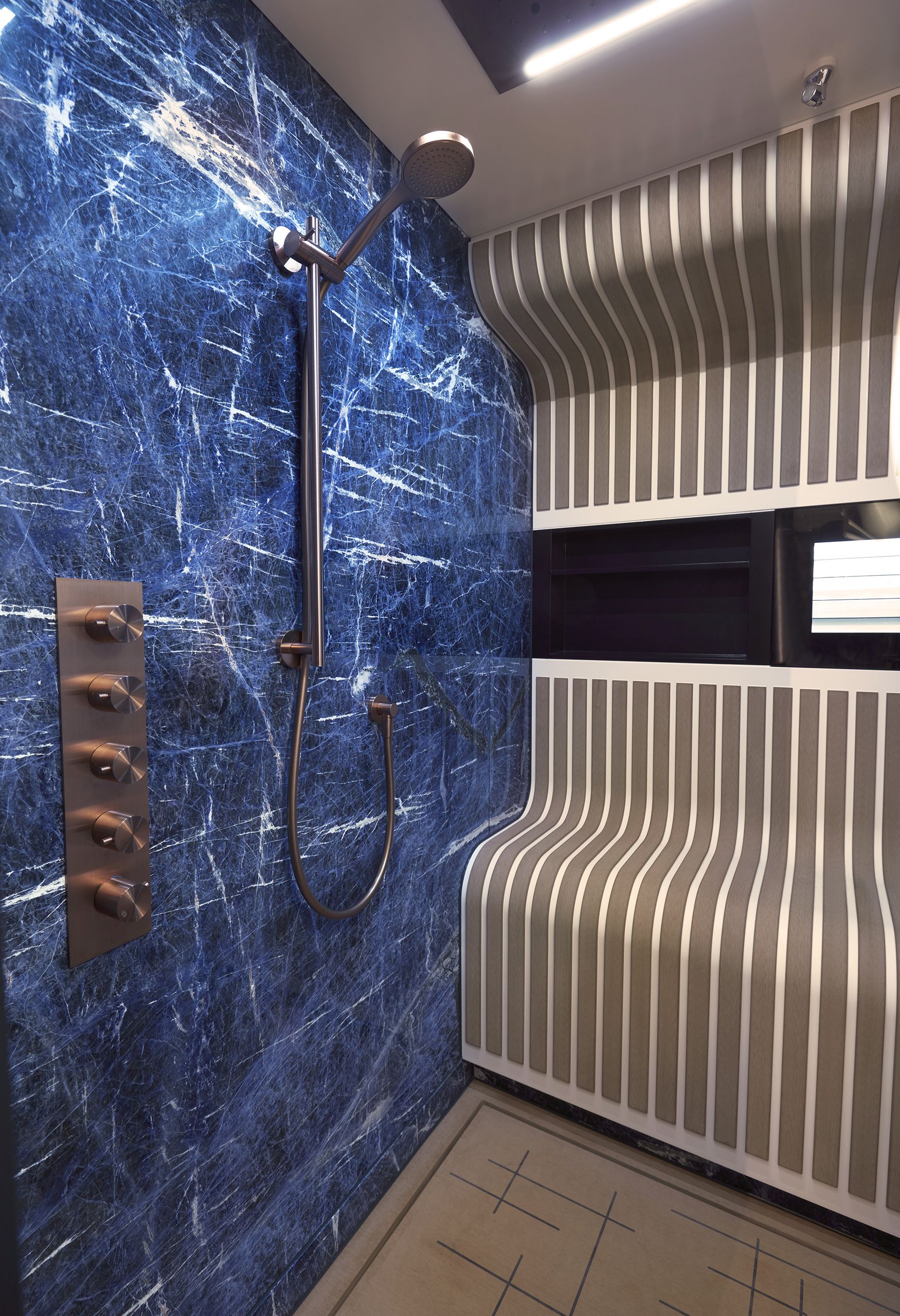
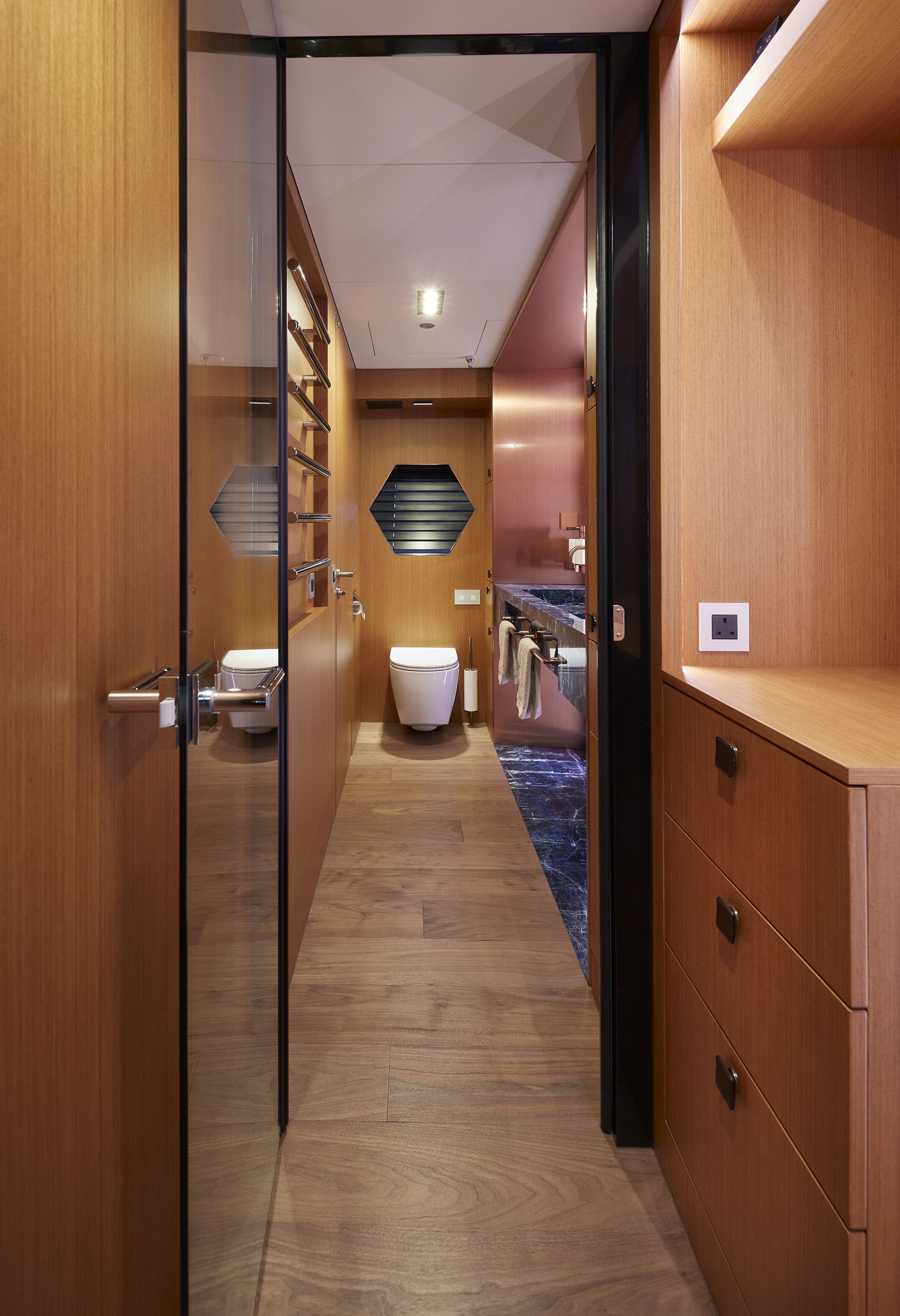
In the owner's suite and the day head (bottom left), rare lapis lazuli from Afghanistan contrasts with rich copper panels
It works well in the owner’s suite, where the lapis contrasts with rich copper panels and dimmable indirect lighting that ranges from hard white through to warm white to simulate daylight. The master cabin runs the full beam of the boat with plenty of hanging space and a vanity table to port. Alternating strips of stitched grey leather and black oak, all with indirect lighting, help the headboard trick the eye by stretching the perspective a little. There are a further three cabins – one large VIP, a double and a flexible twin with sliding beds.
It all just goes to show what you can achieve with collaborative working at the height of a pandemic. A Zoom meeting here, a VR walkthrough there – perhaps this is the future of yacht building for a younger generation of yacht owners. And as they show me round Blue Jeans, de Groot and Bijker impart a sense of the fun involved in this project.
The impressions start before I even step aboard, in fact, when I spot the custom Tenderworks bobbing at the stern. Stencilled on her transom is the name Skinny Jeans. “That tells you everything you need to know about the owner,” says Bijker. “He was extremely happy when he came on board for the first time – I can’t remember how many ‘wows’ I heard!”
Blue Jeans picked up a Neptune at the 2023 World Superyacht Awards in the Semi-Displacement or Planing Motor Yachts, 30m to 34.9m category. See the full list of winners here.
Get BOAT International sent straight to your door, or subscribe and never miss an issue.

